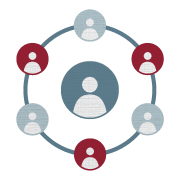You’re probably already aware of the power of referrals
 Especially in the B2B world, it’s no secret that word-of-mouth referrals are among the top ways professional services firms get leads and new business.
Especially in the B2B world, it’s no secret that word-of-mouth referrals are among the top ways professional services firms get leads and new business.
A 2009 study published by the American Marketing Association found that peer recommendations are 2.5 times more responsive than any other marketing channel. And a 2011 study found that referred customers generate higher margins and higher retention than other customers, making them more valuable in both the short and long run.
So why do so many providers miss the mark when it comes to getting referrals?
In order to excel at driving business through referrals, a business must do two things:
Be referrable: offer amazing service
Adding value and delivering on client expectations provides the foundation for word-of-mouth marketing. Even the most robust referral system won’t generate results if you can’t offer an outstanding customer experience.
Develop and implement an effective referral program
But if you’ve refined the customer experience piece, then creating and practicing an effective referral program can have major impacts on your bottom line. Below we’ve outlined the main steps to creating a referral system, and suggestions for putting it into practice. Remember, every business is unique, and your system will need to be tailored to the practices and key players in your marketing strategy.

Step 1: Target your "dream customer"
Targeting the right people is essential for the success of your referral system.
- Define your ideal customer. Take a look at your most valuable customers – they likely share key characteristics that make them amazing (i.e. company size, revenue range, ability to pay on time, personality, demographics, profitability, etc). A deep understanding of your ideal client will boost your bottom line because you can repeat what’s already working for you. It also makes it easier to describe your perfect prospect to referrers.
- Identify your best referrers. Referrers are people who know your company and already think highly of it. Typically, they have some sort of pull on your prospect, either through a personal or working relationship. Referrers can be existing clients, vendors, complimentary service providers, and/or business friends.
Step 2: Educate referral sources
Once you’ve identified your referrers, equip them with the right tools for success:
- Clarify your differentiation. Make sure your referrers understand how your company is unique and how your products and services make a difference to your ideal clients.
- Educate your referrers. Talk to your referrers to help them understand what makes an ideal client for you. This streamlines your process and helps your referrers keep their eyes out for a great match.
- Equip your referrers. Develop valuable content that your referrers can share with their networks. Reports and guides can be easily passed along – either in person or via email. When your referrers have great information to provide to people, they get excited to share it.
- Connect virtually. Update your LinkedIn Profile and LinkedIn Company Page so your referrers can provide online introductions and make connections virtually.
Step 3: Ask for referrals
We understand that asking for referrals can be intimidating. You may worry that your client will think you're pushy or rude. Rest assured – after many years of consulting with a variety of different companies in a myriad of industries, we have only seen positive responses from polite, professional requests for referrals.
Develop a methodical system to ask for referrals from your clients. This will help your company realize an ongoing stream of prospects who come to you via word-of-mouth (the most powerful form of marketing):
- Ask for referrals at key points in your customer relationship. We’ve listed some ideas in our blog post, How to Get Referrals from Your Existing Customers.
- Include “Referrals Appreciated” reminders. You can post these in your email signature, newsletter correspondence, and on your website. This is a good option if you have a broad base of referral sources that you reach out to on a regular basis. If you have forms that you deliver to customers on a regular basis such as receipts of payment, this can be another place to print this message.
- Incorporate referral language into your client appreciation materials. Not only are you nurturing your client relationship, you’re asking for referrals in a more intimate, less invasive way.
Step 4: Recognize your referrers
When you show your referral sources that you appreciate their support, you’re ensuring their continued enthusiasm for sharing your message. There are many ways to recognize your referral sources:
- Simple correspondence is an effective and affordable way to recognize your active referral sources. Make a phone call, send an email, or – better yet – handwrite a note to express your appreciation when they make a referral.
- Giving gifts to clients or partners that refer qualified leads not only recognizes their efforts but encourages additional referrals. Send a gift card, or grant them discounted products or services to express your appreciation when one of their referrals converts.
- Incentivize referrals for key relationships. Certain companies have relationships with the sales reps of complimentary software or types of services. There is often an opportunity to explore a formal spiff arrangement.
Step 5: Measure referral marketing efforts
In order to leverage your referral system for the best results, it’s critical to track your referrals and analyze key metrics. With the right amount of measurement, you can answer questions like:
- Who are my best referral sources?
- How does my referral conversion rate compare to my overall lead conversion rate?
- What’s the ROI for my referral system?
- How can I refine my referral system for a greater ROI?
Incorporating these elements into your marketing strategy will put you on track for an effective referral system that drives business and makes you more profitable. You can also tie it into your Customer Relationship Management (CRM) software so that your sales team is sure to input sales made as a result of referrals.
Just remember, a referral system won’t take you far if you can’t fulfill your brand promise. So while you’re thinking about ways to create or improve your referral system, also consider how to refine your offerings and to be more referable. Because the greatest way to generate more business is to give your customers something to talk about.

 Especially in the B2B world, it’s no secret that word-of-mouth referrals are among the top ways professional services firms get leads and new business.
Especially in the B2B world, it’s no secret that word-of-mouth referrals are among the top ways professional services firms get leads and new business.